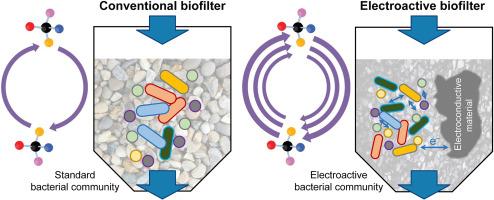Enhanced removal of chiral emerging contaminants by an electroactive biofilter
IF 14.3
1区 环境科学与生态学
Q1 ENVIRONMENTAL SCIENCES
引用次数: 0
Abstract
50% of pharmaceuticals and 25% of herbicides used worldwide are chiral. Each enantiomer has a unique toxicity and biodegradation profile, affecting differently to organisms. Chirality plays a key role in the behavior of these emerging contaminants (ECs) in terms of their pharmacological or herbicidal activity, but this peculiarity is often overlooked in environmental research. The complexity of chiral ECs is underestimated, as the varying sensitivity of biological systems to enantiomers is rarely considered. Biofilters can promote the activity of specific microbial communities, facilitating the degradation of ECs, due to the greater interaction between water and microorganisms and their compact design. Here, we show that an electroactive biofilter can alter the chirality of drugs and herbicides in wastewater treatment, impacting their removal and toxicity. The electrochemical biofilter (BioeF) removed 80% of pharmaceuticals and 50–75% of herbicides, outperforming the conventional filter (ConF). BioeF also showed greater chiral alterations and lower ecotoxicity. This work provides the first evidence of a relationship between changes in contaminant chirality and detoxification capacity, enhanced by electroactive systems. The increased microbial activity observed in the BioeF suggests that bioelectrochemical systems offer a valuable advance for ECs removal and ecotoxicity reduction, addressing the environmental challenge posed by ECs.

利用电活性生物滤池提高手性新污染物的去除率
全球使用的 50% 的药品和 25% 的除草剂都是手性的。每种对映体都具有独特的毒性和生物降解特性,对生物体的影响各不相同。手性对这些新出现的污染物(ECs)的药理或除草活性起着关键作用,但这种特殊性在环境研究中往往被忽视。人们低估了手性 EC 的复杂性,因为很少考虑到生物系统对对映体的不同敏感性。生物过滤器可以促进特定微生物群落的活性,从而促进对氨基甲酸乙酯的降解,这是因为水与微生物之间的相互作用更大,而且生物过滤器设计紧凑。在这里,我们展示了一种电活性生物滤池可以改变废水处理中药物和除草剂的手性,从而影响它们的去除和毒性。电化学生物滤池(BioeF)可去除 80% 的药物和 50-75% 的除草剂,性能优于传统滤池(ConF)。BioeF 还显示出更大的手性改变和更低的生态毒性。这项工作首次证明了污染物手性的变化与解毒能力之间的关系,并通过电活性系统得到了增强。在 BioeF 中观察到的微生物活性的增加表明,生物电化学系统为去除有机污染物和降低生态毒性提供了宝贵的进展,从而解决了有机污染物对环境造成的挑战。
本文章由计算机程序翻译,如有差异,请以英文原文为准。
求助全文
约1分钟内获得全文
求助全文
来源期刊

Environmental Science and Ecotechnology
Multiple-
CiteScore
20.40
自引率
6.30%
发文量
11
审稿时长
18 days
期刊介绍:
Environmental Science & Ecotechnology (ESE) is an international, open-access journal publishing original research in environmental science, engineering, ecotechnology, and related fields. Authors publishing in ESE can immediately, permanently, and freely share their work. They have license options and retain copyright. Published by Elsevier, ESE is co-organized by the Chinese Society for Environmental Sciences, Harbin Institute of Technology, and the Chinese Research Academy of Environmental Sciences, under the supervision of the China Association for Science and Technology.
 求助内容:
求助内容: 应助结果提醒方式:
应助结果提醒方式:


